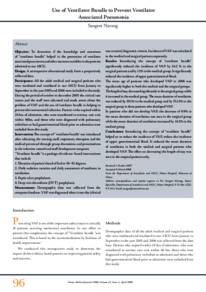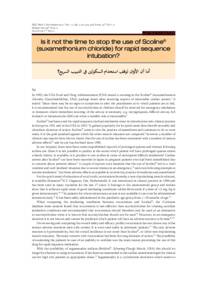Document
Use of ventilator bundle to prevent ventilator associated pneumonia.
Publisher
Oman Medical Specialty Board.
Gregorian
2008-04
Language
English
English abstract
Objective: To determine if the knowledge and awareness
of "ventilator bundle" helped in the prevention of ventilator
associated pneumonia and other outcome variables in the patients
admitted to our AICU.
Design: A retrospective obsevational study from a pospectively
collected data.
Participants: All the adult medical and surgical patients who
were intubated and ventilated in our AICU from January to
September in the year 2005 and 2006 were included in the study.
During the period of october to december 2005 the critical care
nurses and the staff were educated and made aware about the
problem of VAP and the use of vrntilator bundle in helping to
prevent this nososcomial infection. Patient s who expired within
24 hrs of admission, who were transferred to tertiary care unit
within 48hrs, and those who were diagnosed with pulmonary
embolism or had gastrointestinal bleed prior to admission were
excluded from this study.
Intervention: The concept of " ventilator bundle' was introduced
after educating the nursing staff, respiratory therapists and the
medical personnel through group discussions and presentations
in the infection control and staff development symposia.
"Ventilator bundle "is a package of evidence -based interventions
that include
1. Elevation of patient's head of bed to 30- 45 degrees.
2. Daily sedation vacation and daily assessment of readiness to
extubation.
3. Peptic ulcer prophylaxis.
4. Deep vein thrombosis (DVT) prophylaxis.
Measurement: Demographic data was collected from the
computer database. VAP was diagnosed when it met the (clinical
non invasive) diagnostic criteria. Incidence of VAP was calculated
in the medical and surgical patients separately.
Results: Introducing the concept of "ventilator bundle"
significantly reduced the incidence of VAP by 24.2 % in the
surgical patients and by 12% in the medical group. It significantly
reduced the incidence of upper gastrointestinal bleed.
The mean age of patients who developed VAP in 2006 was
significantly higher in both the medical and the surgical groups.
The length of stay decreased significantly in the surgical group, while
it increased in the medical group. The mean duration of ventilation
was reduced by 29.1% in the medical group and by 55.12% in the
surgical group in those patients who developed VAP.
In patients who did not develop VAP, the decrease of 9.9% in
the mean duration of ventilation was seen in the surgical group
while the mean duration of ventilation increased by 14.2% in the
medical group.
Conclusions: Introducing the concept of "ventilator bundle"
helped us to reduce the incidence of VAP, reduce the incidence
of upper gastrointestinal bleed. It reduced the mean duration
of ventilation in both the medical and surgical patients who
developed VAP. The effect on decreasing the length of stay was
seen in the surgical patients only.
Member of
Resource URL
Category
Journal articles


